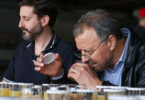Athens, Ga. – Stressed corals lose the symbiotic algae that help them survive in a process known as bleaching, but University of Georgia researchers have discovered that one subtype of the symbiotic algae that live mostly in shallow-water corals of the Caribbean provide resistance to environmental stress.
The researchers, who include plant biologists Gregory Schmidt and Brigitte Bruns and ecologists William Fitt and Jennifer McCabe Reynolds, showed for the first time that clade A Symbiodinium has complementary mechanisms for surviving in its coral hosts during periods of warmer-than-normal water temperatures and intense late-summer sun.
They also found that deeper-water corals host other Symbiodinium types that are more sensitive to elevated temperatures and high light and bleach more extensively during periods of ocean warming.
“It seems that clade A Symbiodinium have an extraordinarily high capacity to control excess light energy by cycling electrons through atypical cyclic pathways,” said Schmidt, who has been studying photosynthesis in green algae and plants for four decades. “These enable continued light energy utilization even when loss of the conventional linear pathway occurs, as is the case for the symbiotic algae of bleaching-susceptible corals.
“Also, to protect the core photosynthetic complexes from excess light damage, we found that clade A Symbiodinium very rapidly undergoes disorganization of photosynthetic antenna pigment complexes. This provides shading, rather than enhancing the capture of light energy and transfer to reaction centers. We reported sometime ago that repair of damage to the photosynthetic apparatus is impaired at elevated temperatures, so preventing photodamage in the symbiont should confer thermal tolerance to the corals.”
All reef-building coral species host unicellular algae that live within cells of tentacle-bearing polyps. The yellow-brown algae, called zooxanthellae, support their host’s survival by carrying out photosynthesis and providing nutrients that stimulate construction of reef coral colonies. In addition to their ability to provide carbon dioxide fixation at rates equivalent to those of forests, the algae also lend color to coral tissues, which otherwise are pale.
Corals bleach by losing their beneficial algae when stressed. While corals can usually recover from short-term stressful episodes, prolonged events such as during an El Niño period, can cause permanent bleaching and death of vast expanses of coral reef. The 1997-1998 El Niño remains the strongest such event on record. That year, sea surface temperatures were the highest ever recorded, and coral reefs worldwide suffered the most extensive bleaching and mortality in modern times.
Ph.D. candidate Jennifer McCabe Reynolds, who conducted most of the experiments, measured changes in chlorophyll fluorescence, the excess energy re-emitted from an organism, to track photosynthetic processes.
“We were interested in exploring why some coral species in the Florida Keys that host clade A Symbiodinium appeared very healthy compared to corals that lack clade A,” she said. “We developed a new technique that we call serial irradiation pulses, or SIPs, which enables us to detect unusual fluorescence signal changes that reflect the presence of photoprotection mechanisms. We used a special fluorometer that can be taken underwater to measure photoprotections in cultured cells in the lab or with intact coral in the field.”
In the past decade, scientists have identified symbiont algae in clades from A through H, differing in their genetic and physiological characteristics. The UGA researchers found the clade A Symbiodinium also live within jellyfish, anemones and giant clams in addition to reef-building corals.
In the deeper waters of the Caribbean, clades B and C are the most common coral symbionts, while clade C is more predominant in the reefs of the Pacific. Because those Symbiodinium are deficient in the photoprotection mechanisms described in the new report, the researchers say this may explain why deeper-water corals with non-clade A symbionts bleach more readily from the warmer-than-normal water temperatures and intense sunlight conditions, typical in late-summer Caribbean waters.
While it is tempting to conclude that corals with clade A symbionts will prevail in reefs if ocean warming becomes more severe, Schmidt is cautious. “There are many pressures acting on corals, including disease, pollution and coastal development,” he said. “And, of course all must be considered in any speculation on the future of coral reef health.”
The team’s work, funded by the National Science Foundation and a Dr. Nancy Foster Scholarship from the National Oceanic and Atmospheric Association to Jennifer McCabe Reynolds, was published in the September 9 issue of the journal, Proceedings of the National Academy of Sciences.







